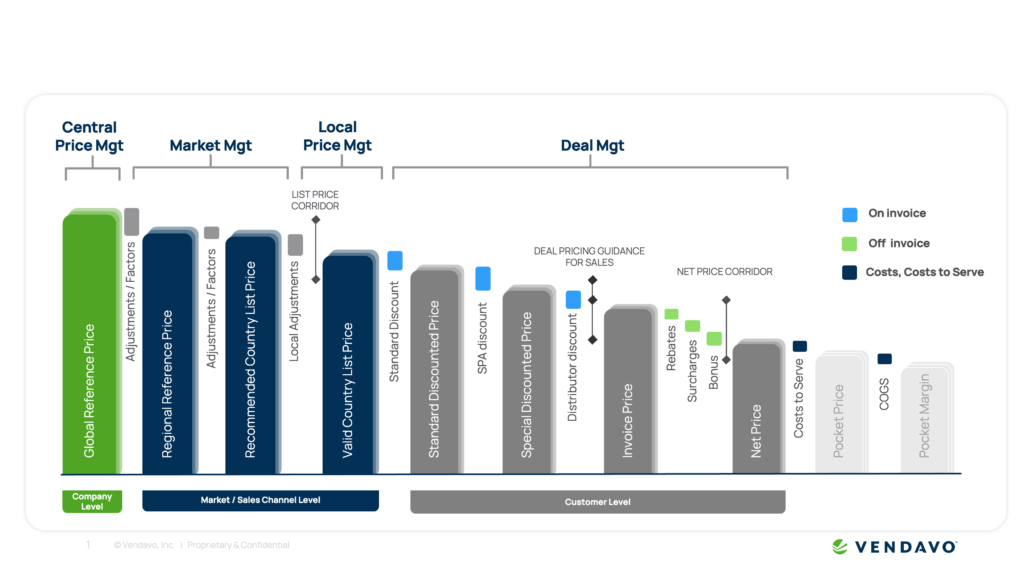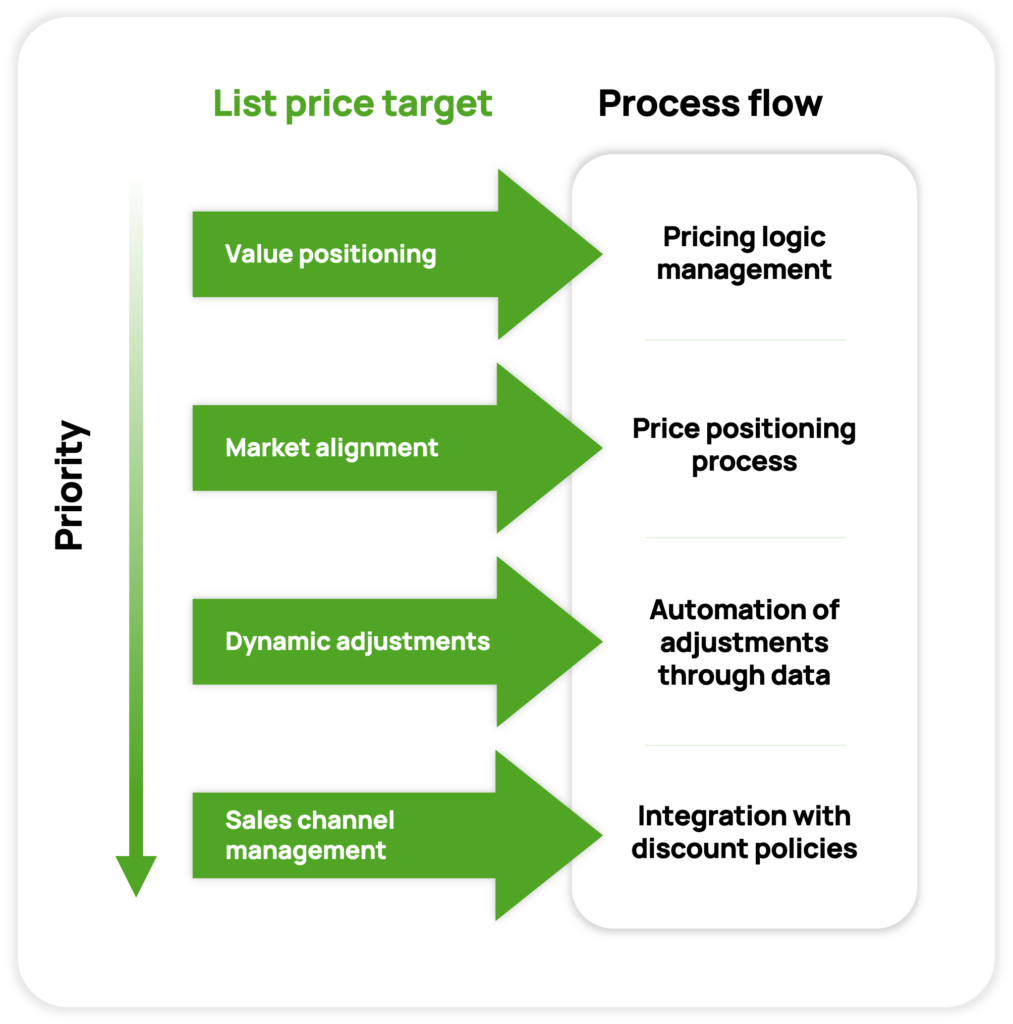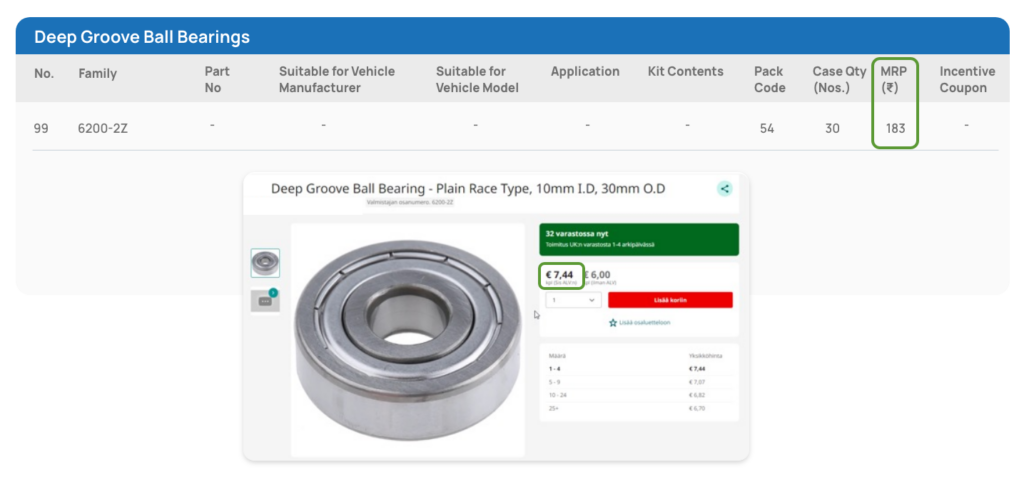
Kalle Aerikkala, Business Consultant at Vendavo, illustrates what list pricing is, benefits, disadvantages, and key considerations to make when setting list prices in your organization.
What is List Pricing?
List pricing refers to the price a manufacturer or supplier sets for their products or services without negotiations or discounts. List pricing is a starting point for price negotiations and can provide a standard price for customers to compare suppliers. It is an essential aspect of the business-to-business (B2B) pricing structure in many industries.
You may have heard a different name for list pricing like reference price, manufacturer suggested retail price, or sticker price. The term used usually depends on the industry.
Why is List Price Transparency Important?
List price transparency is important in many modern businesses to offer easy access to pricing to customers, including clear explanations of any additional charges or fees. Transparent list prices help build trust and foster long-term relationships with customers. The difference between business-to-business and business-to-consumer is significant in this perspective. In B2C, list prices are used much more in transactions, and differentiation from these prices is done differently than in a B2B environment. Outside the usual competition legislation, there are usually little or no legal requirements for list pricing in B2B settings.
List price is often the very first pricing element in the price waterfall. It can be set on different levels, global, regional, local, or differentiated by industry. List prices and the difference between them and cost price are illustrated in the figure below, which represents an ordinary price waterfall.
An Example of a Price Waterfall

This price waterfall represents a common approach to differentiating list prices by geography. This approach allows you to easily explain and defend list prices based on differences, such as import costs. Learn more about the Power of the Pricing Waterfall.
Defining List Pricing in Your Organization
There are many considerations to make when defining and setting your list prices.
Often list price is defined on a level to reflect the highest price a small customer would pay when buying a single or low volume of that product or service. This is common, but not the only definition for a list price, or sometimes referred to as pricing lists.
Another key definition for an organization is the structure of list prices. For example, there may be more than one list price needed for each market. In this case, a definition on the method to differentiate the list prices is important to create the best positioning.
Another very important definition in B2B business is the visibility and availability of list pricing information. You’ll need to consider whether you will publish your prices publicly, make them available online for identified users, or only inform customers about pricing after a specific request from them. There are established conventions for both of these definitions in each industry, but having a pricing strategy that breaks the mold can prove very successful.
Defining the meaning and availability of list prices will inform the next steps in the pricing process where an organization defines how they actually set the list prices.
Methods for Setting List Prices
There are several methods to set list prices. Three of the most common are cost-based pricing, competitive pricing, and value-based pricing.
Cost-Based Pricing
One of the most common approaches to list pricing is to determine the cost of manufacturing or providing a product or service and add a markup. The markup can cover the expenses of research and development, marketing, and other overhead costs and desired profit.
Competitive Pricing
Another approach to list pricing is to look at competitors’ prices and set the price at a similar level to the desired offset based on pricing strategy. This strategy benefits new entrants into the market who may not have a strong reputation or brand image.
Value-Based Pricing
This approach to list pricing is based on a product or service’s value to the customer. The price is set based on the perceived value of the product or service in the market.
Taking a dynamic pricing approach to setting list prices will pay dividends. For example, you can set a lower list price for a product during off-peak seasons and increase it during peak periods. When you introduce dynamic elements to pricing, you can learn and adapt faster to market development. Don’t forget to follow up on the success of the price change through revenue and margin growth metrics.
The Benefits of List Pricing
There are some key benefits when an organization uses list prices:
Enforce the Value of Your Products and Services
List pricing enforces the value of your product or service. It helps you create differentiation and position yourself against your competitors. From an internal perspective, list prices should be used to create the correct value positioning within the portfolio. This will help you efficiently communicate the value of your different products and services to the market.
Build Price Differentiation and Optimization
An important aspect of list price is that it creates a reference point from which the price differentiation and price optimization process can start.
Create an Easier and More Efficient Price Optimization Process
The price optimization process is much easier and more efficient when solid list prices are in place. Whether your organization negotiates prices with individual customers or sets price differentiation through more general segments, prices can greatly affect profitability.
Price More Consistently
List prices will also help you price more consistently through various channels. This is true because distributors can always refer to the official list price as their reference. By referring to the reference prices, your channel partners will be able to better understand the overall profitability. This principle also applies when managing prices across many countries and markets. In this scenario, the reference point that list prices create will help you optimize the balance between local price accuracy and gray market risk.
The Disadvantages of List Pricing
The main disadvantage of list prices is the perceived rigidity of pricing within an organization. Whether this perception is warranted or not, can be influenced by the maturity level of the price management process. Additionally, list prices can take over too much of the pricing focus by neglecting the mechanisms to reach the actual customer price. This may lead to a situation where the revenue and profitability could be expected to grow, but they remain flat or even decrease. For this reason, it is imperative to use intelligent growth analytics to understand the true impact of list pricing.
The List Pricing Process
The key to having success with list prices is to manage them with an efficient process. The process must be designed around the key objectives set for list prices. In some businesses, the most important function of list price is to provide internal positioning across your product and service portfolio. In other cases, the focus should be on aligning prices to the market situation. Whatever the exact focus area is, ensuring that it is at the core of the list pricing process will allow the business to take full advantage of list pricing.
If you’re managing prices you should rank your objectives, then assign the corresponding process flow and set your priorities.

When pricing matures, the list price management can also move into the list price optimization approach. This is especially valid when a high share of the business is transacted on the list price level as with ecommerce. In this scenario, a specific approach to optimize list prices directly instead of through something like customer discounts can bring great advantage to the business.
Key Considerations When Setting List Prices
As list prices are usually the starting point of the price waterfall, they are fundamental to profitability. When working on setting prices, some steps are always necessary to take.
1. Use Profitability Analytics
First, use profitability analytics. These insights will inform how you set list prices and will help you shape your pricing strategy. Read more about best practices in profitability analytics here.
2. Be Strategic About Changing Your Prices
Next, define your strategy for changing prices once they are set. Even if continuous price changes are not targeted through dynamic pricing, planning price change intervals and integrating them into the overall sales and customer management practices is necessary. This process integration is required as any list price change will impact several customer prices.
3. Focus on Continuous Improvement and Maturity Progression
Perhaps most importantly, always work toward improving your list pricing maturity. How can you introduce elements that can offer greater profitability to your pricing, such as list price optimization procedures and more frequent or dynamic list price changes? When setting up list pricing, it is always beneficial to focus on the most valuable elements right now, while laying a strong foundation for the future.
Examples of List Pricing
There are plenty of interesting practical examples of list pricing. Let’s examine a list price case where the price is significantly different from the actual transaction prices.
Below is a snapshot of public list prices by a manufacturer, along with an image of the same product on sale by a dealer with a price to a small buyer. The reference price set by the manufacturer is roughly 25 higher than the transaction price, even for a small buyer.

When it comes to this organization’s list price target priorities, they seem to have two goals in mind: internal value positioning and sales channel management. This may very well be the optimal setup for prices or perhaps they may consider aligning the list prices to more realistic levels in the market.
How Vendavo Can Help with List Pricing
Vendavo can help your pricing teams set, manage, and share pricing strategies. With flexible pricing logic, configurable rules, and calculations, you can rely on Vendavo to scale strategies across your catalogs of products, regions, countries, channels, and customers. We’ll help you ensure that the right price is always shared with your sellers and channels, no matter the context. With Vendavo, pricing teams have the ability to leverage up-to-date insights to dynamically adjust pricing in near real time, to close the gap between strategy and execution in today’s volatile and unpredictable market conditions.
If you’re looking to provide your pricing team with the ability to define list prices, Vendavo Pricepoint is a helpful solution. In addition, Vendavo’s Value Acceleration team can support in defining the most suitable list pricing calculations, market adjustment approach and any list price optimization projects.
List Pricing Key Takeaways
- Make sure to define your list prices well. Define the meaning of your list prices initially and stay true to those definitions. This definition will then inform your pricing methods, whether you’re using a value-based, market-driven, or different pricing strategy.
- Decide on your list price target priorities. Usually, in list pricing, the targets, and especially the actions to reach those targets, can be conflicting. It is essential to make a conscious decision about which of the targets should be emphasized in case any conflict arises.
- Set up a strong foundation and plan for future improvement. If you are setting up list pricing for the first time or changing your existing setup, addressing the most critical issues immediately and building the list pricing core for long-term support will provide the most profitable outcome.